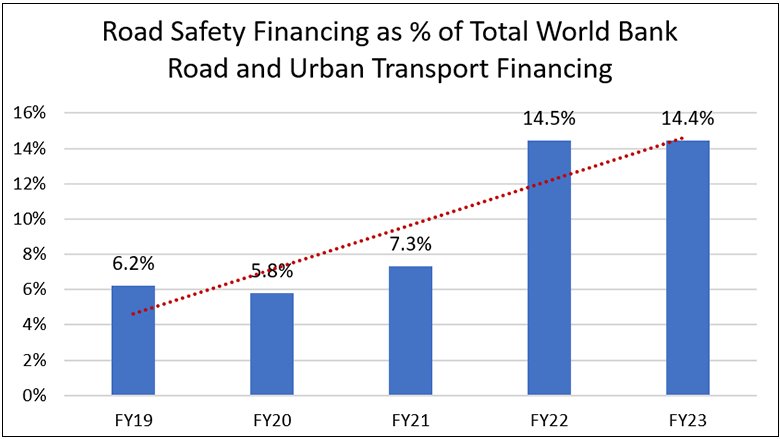Key Achievements
- An estimated 65 million people were provided with access to safer roads between mid-2018 and mid-2023 through World Bank-financed projects.
- Between 2010 and 2019, 10,000 km of roads built or rehabilitated with World Bank support achieved significant safety gains after incorporating recommendations from GRSF-funded safety assessments.
- 270 fatalities and serious injuries were prevented in Nepal as a result of crash barriers installed between 2015 and 2017 through the World Bank-supported Road Safety Support Project. Extrapolating the trend, the project could save over 3,400 lives during the lifetime of the investment.
- Between 2013 and 2022, Iraq recorded a 81 percent reduction in annual road crash fatalities—from a baseline of 113 to an actual value at project closing of 21—along two major traffic corridors due to road safety improvements under the World Bank-financed Transport Corridors Project.
- Between 2015 and 2021, Tanzania recorded a 79 percent reduction in road traffic fatalities —from 33 to 7—along the project corridor of the World Bank-financed Dar es Salaam Urban Transport Improvement Project (phase 1).
- From 2013 to 2022, Albania recorded 68 fewer annual fatalities on primary and primary-secondary roads—a 23 percent reduction—as a result of the World Bank-financed Results-based Road Maintenance and Safety Project.
- Nearly 22,000 professionals were trained on road safety between 2015 and 2023. Knowledge imparted in these trainings has been used by local transport officials to perform road safety audits and implement life-saving road safety interventions.
Challenge
According to the World Health Organization (WHO), road traffic crashes killed 1.19 million people worldwide in 2021—more than malaria or HIV/AIDS. Road crashes are the leading cause of death among children and young people between the ages of five and 29, and the twelfth leading cause of death for all age groups. Vulnerable road users—pedestrians, cyclists, and motorcyclists—comprise more than half of global road traffic fatalities. The burden of road crashes is particularly high in low- and middle-income countries (LMICs), which account for 92 percent of all road traffic fatalities.
Road crashes are not only a human tragedy and a major public health issue, but also impose high socioeconomic costs, especially on the poor. The total economic costs of road traffic fatalities and injuries in LMICs range between 2-6 percent equivalent of gross domestic product (GDP), according to GRSF estimates.
Approach
The World Bank’s approach to improving road safety in LMICs over the decade from mid-2013 to mid-2023 has revolved around three types of interventions.
First, the World Bank has steadily bolstered efforts to ensure that all its supported road projects improve safety, such as through the introduction of traffic calming measures and pedestrian crossings on busy urban roads, and the installation of crash barriers and speed cameras on inter-urban highways. Beginning in 2018, the World Bank included road safety in its Environmental and Social Framework to ensure that all World Bank-financed road projects meet or exceed safety standards, which was a first among Multilateral Development Banks (MDBs). In 2020, the World Bank took the additional steps of requiring that all transport investments with a road component include road safety in the economic analysis of the project, and that they achieve a reduction in road traffic fatalities over the lifetime of the investment.
Moreover, the World Bank directly finances road safety projects around the world, including supporting stronger road safety management and enforcement capacity, enhancing vehicle safety standards, improving data management systems, and engaging with civil society and the private sector. In the period from mid-2013 to mid-2023, the World Bank has committed $3.34 billion globally toward road safety. This included two standalone road safety projects in 2022, in Bangladesh and India.
GRSF has also catalyzed investments in road safety. GRSF was established in 2006 to provide funding, knowledge, and technical assistance to scale up road safety investments in LMICs. Over the last decade, GRSF has been instrumental in catalyzing much of the World Bank’s road safety investment through the provision of $52 million in grants for the preparation and implementation of projects with a road safety component.

